Despite the rise in social media marketing, email marketing still remains a powerful tool both for B2B and B2C businesses. However, with our mailboxes carefully tuned and filtered, it is getting harder and harder to gain the audience’s attention. Even though Marketing Sherpa’s study recently revealed that 72% of customers prefer email communication with brands, it is not always easy to convey your message to the right client.
This is especially so around big sales times like the holiday season (which is already upon us). The good news, though, is that there are proven techniques to engage your customers that work most of the time. And by “most of the time”, we mean that every email campaign still has to be customized. Remember that marketing, in general, will always need to be tested by trial and effort.
So, here are some practical email marketing tips that will help you write the best B2C emails for the holiday season right now and even help you with Easter sales down the road (yes, you better save them for later).
1. Don’t underestimate the subject line
Duh, right? A boring subject line will of course never get your email opened. So, if you would really like to boost your holiday season sales (or any other sales for that matter), it’s time to recall what it was like to think of narrative essay topics. No kidding, by the way. Your subject line should tell a story — shortly, but vividly.
Here is a great, actionable and intriguing example from the GetResponse team:
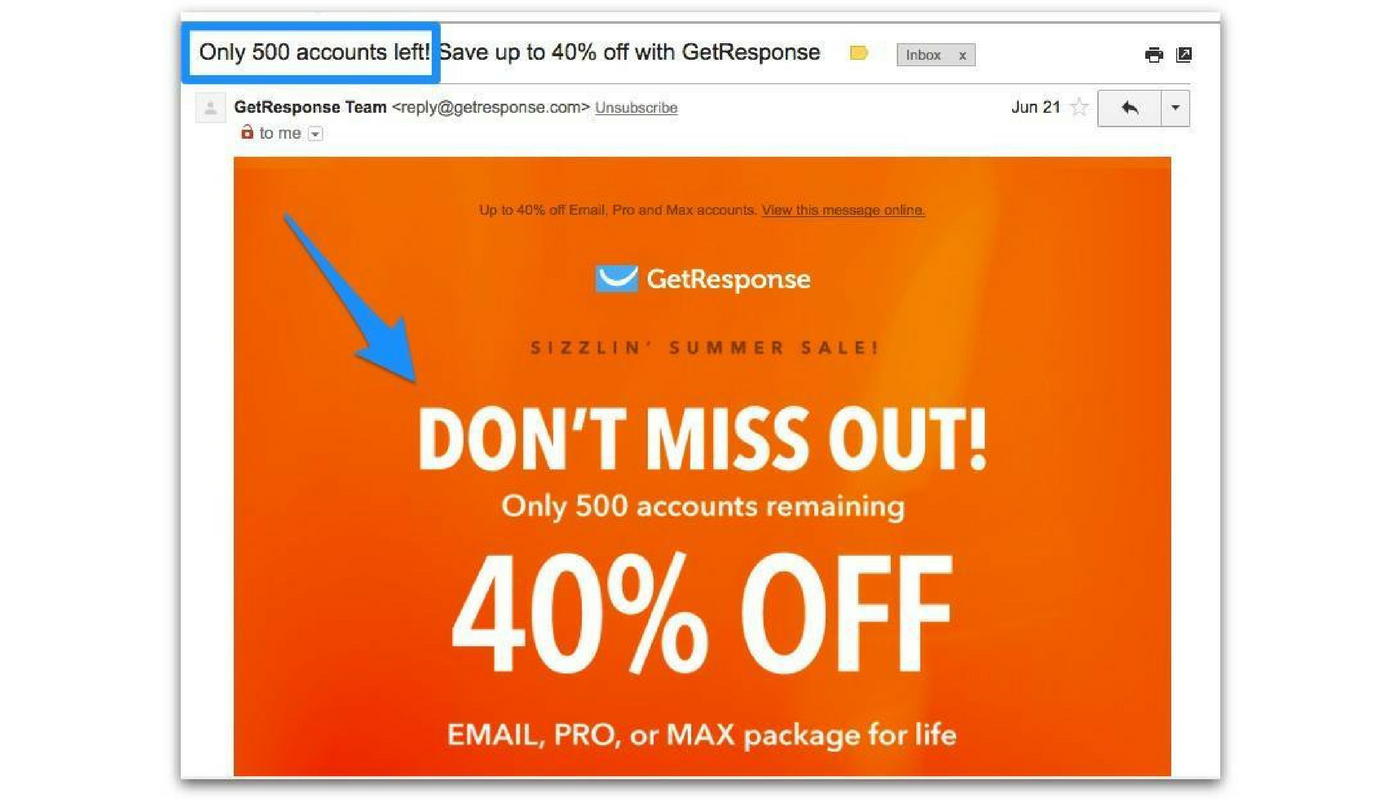
This subject line works for so many reasons. For starters, it gives the recipient a sense of urgency — only 500 accounts left. Next, it does not bury the lead, it goes straight to the point (in this case, a 40% discount).
2. Personalize whenever possible
Emails that have the recipient’s name in the subject line consistently have a higher open rate (by 26% in comparison to generic letters). More than that, a Direct Marketing Association report states that 36% of all email marketing revenue is attributed to personalized emails. Even though every customer understands that his/her name in the subject line is nothing but email automation, it still does the trick on a subconscious level. After all, we all have the need to feel special, and addressing each potential buyer by their name helps to establish an emotional connection — something that always pays off.
3. Make it actionable
Many marketers today argue that businesses should include a call-to-action (CTA) in every email marketing campaign. And they’re right. You do need a CTA if you want your email subscribers to actually take some kind of action. After all, you wouldn’t want your clients to guess what it is you want from them, right?
 Source: HubSpot
Source: HubSpot
The example above (“download now”) is one of the most obvious CTA examples. Depending on the type of action you want your subscribers to take, the actual CTA may differ. For Black Friday sales, you might use the phrases: “Buy Now”, “Shop Now” or maybe “Go to Sale”.
4. Focus on clarity
Make sure the emails you send out are crystal clear. Take a look at the great example above. Crate&Barrel conveys quite a lot of information in a clear and succinct manner. You can see the occasion of the sale (winter clearance), the discount rate (up to 60%), and, if you’re interested enough to look just a little bit closer, you will see the which items are for sale (dinnerware, drinkware, pillows, rugs, and furniture).
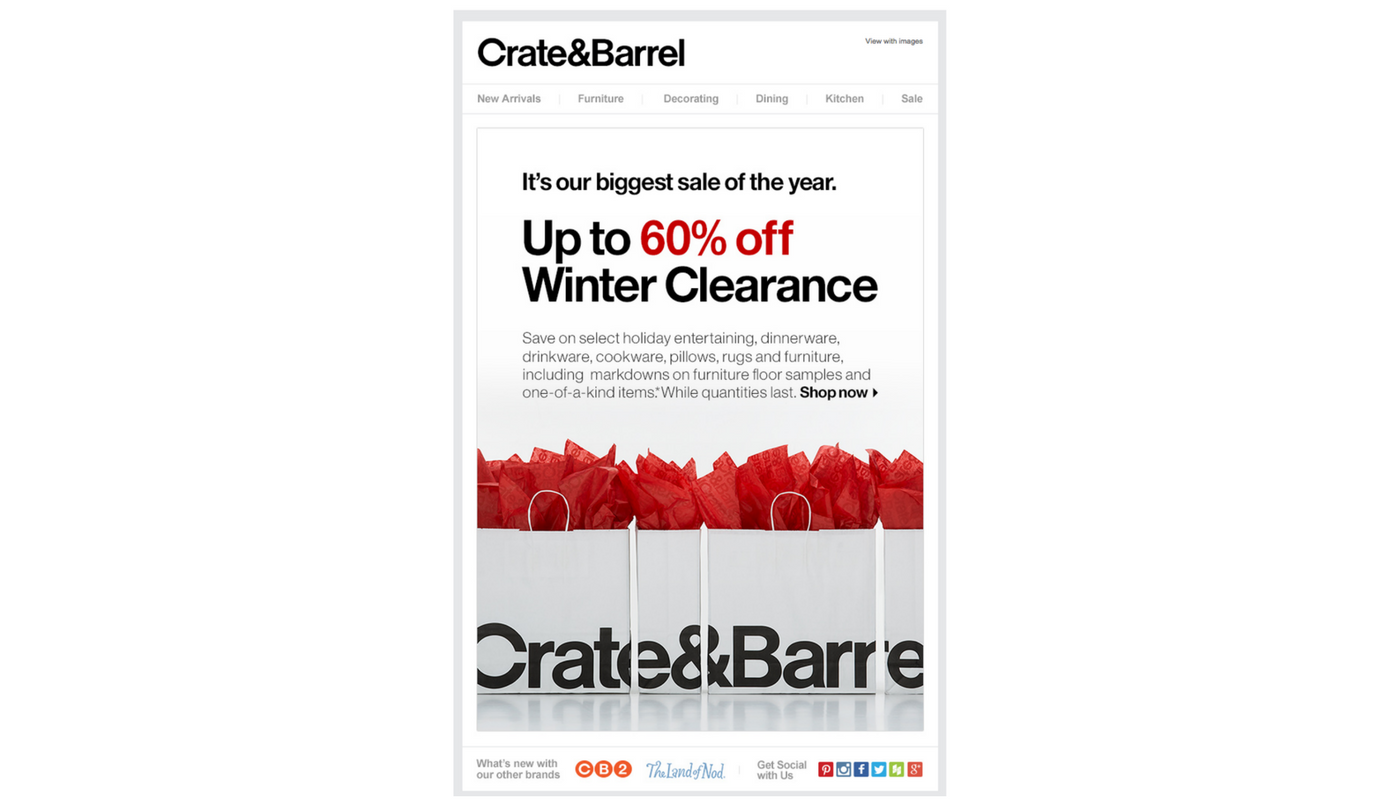
5. Put the stress on “you”, not “us”
A lot of brands still make this mistake; they focus on themselves and their products, while the focus that sells is always on the customer. Harsh as it may sound, nobody cares about you or your product — not until you give customers a good reason to do so.
So, here is a great idea from Navabi: absolutely no ‘we,’ ‘us,’ or ‘ours.’ It’s all about the customer, and everyone who decides to open this email can see it right away: “your exclusive 15% off”, “your shopping bag.” [emphasis mine]

6. Make it relevant: emphasize the benefits
One of the surest ways to make your potential buyers care about your product or service is to emphasize the benefits right away. Once again, remember the tips above. Do not make it about your company; make it about your customer instead. A good question to ask here: what can your customers gain from you?
Here’s a great example of how Uncommon Goods did it:
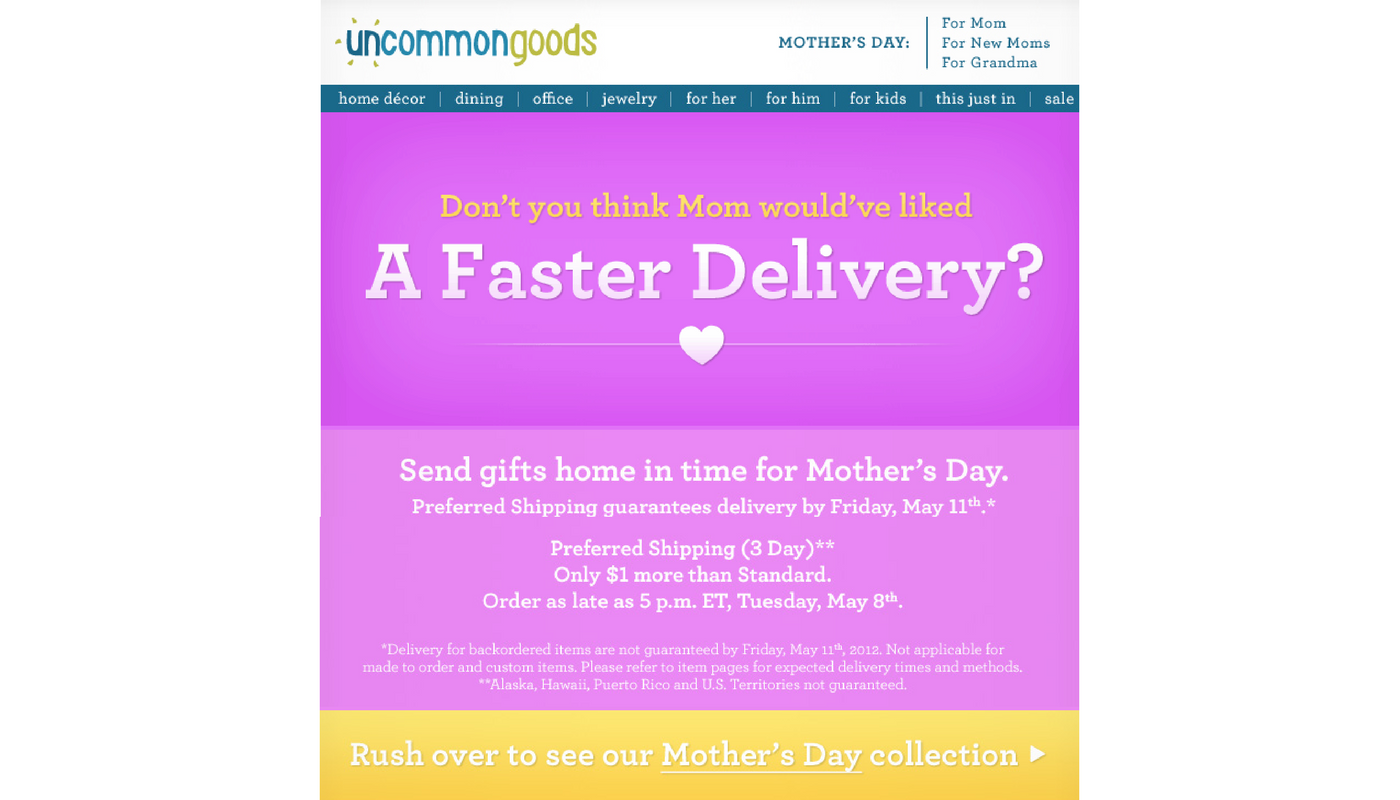
In this email, the customer can see the upside right away: “a faster delivery”. The inscription stands out and immediately catches the eye. And let’s agree: we all would LOVE a faster delivery. So, we’re hooked and keep reading for more.
7. Stay brief
No one wants to sift through pages of data. No one wants to read long emails. In fact, you should get to the point as quickly as possible. This way, you kill two birds with one stone: increase the chances of your email conveying the message it aims to convey and show your clients that you value their time.
Here is a fantastic email example from Greats.com:
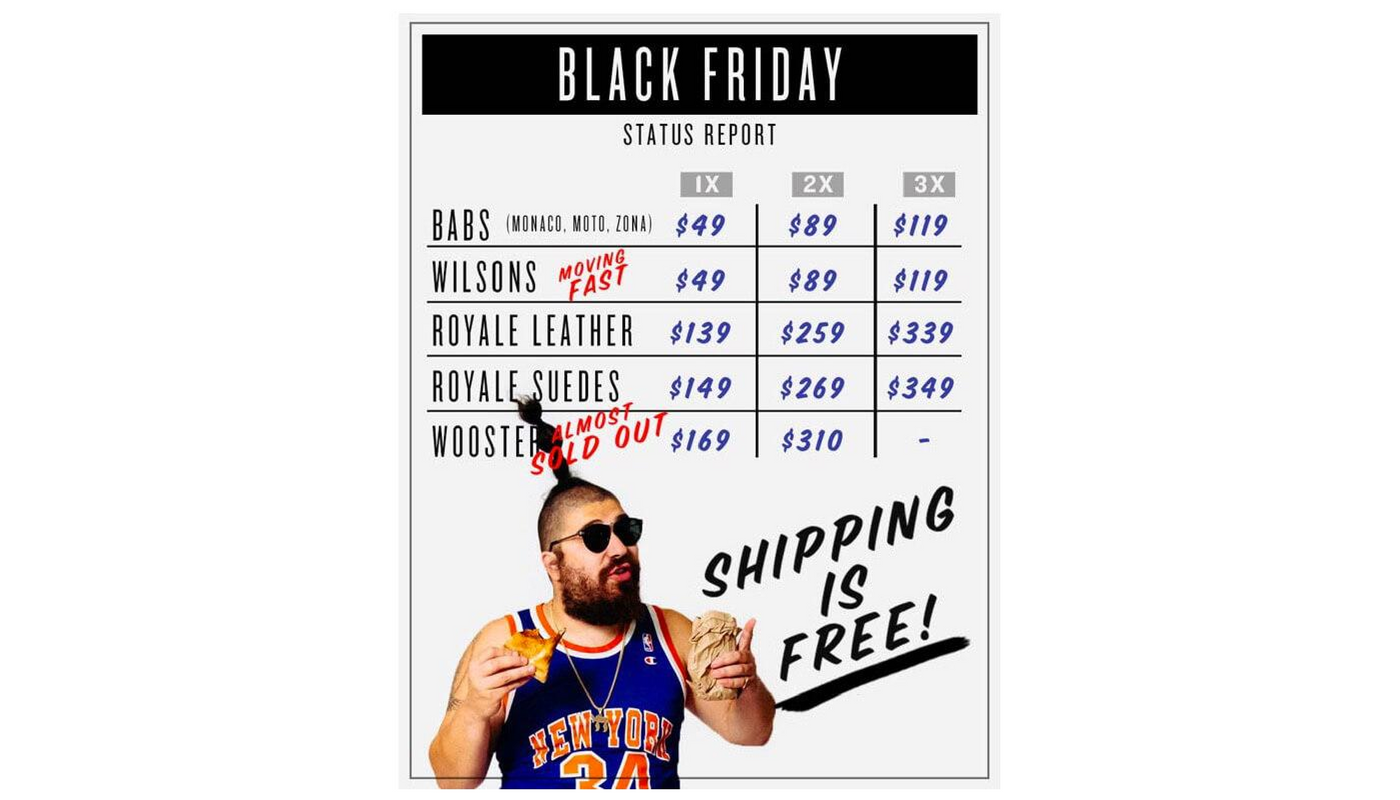
It’s simple, it’s very visual, and it’s to the point. Basically, all it does is present a table with their discount rates — no unnecessary text, no distractions, no excessive information. The whole letter is sweet and informative.
8. Appeal to emotions
Charity sales and other great causes raise a lot of funds because of one simple reason: they all appeal to human emotions. Sure, it is not always possible to do so with a typical holiday season sale, but you can often find a way.
For example, a great way to appeal to emotions would be to use a dash of humor. Humor works great for any target audience… The trick is to find the perfect joke to go along with your target buyer. Here’s how Chubbies did it:

9. Be visual
While all of the above examples are pretty visual, here is one more example for you:
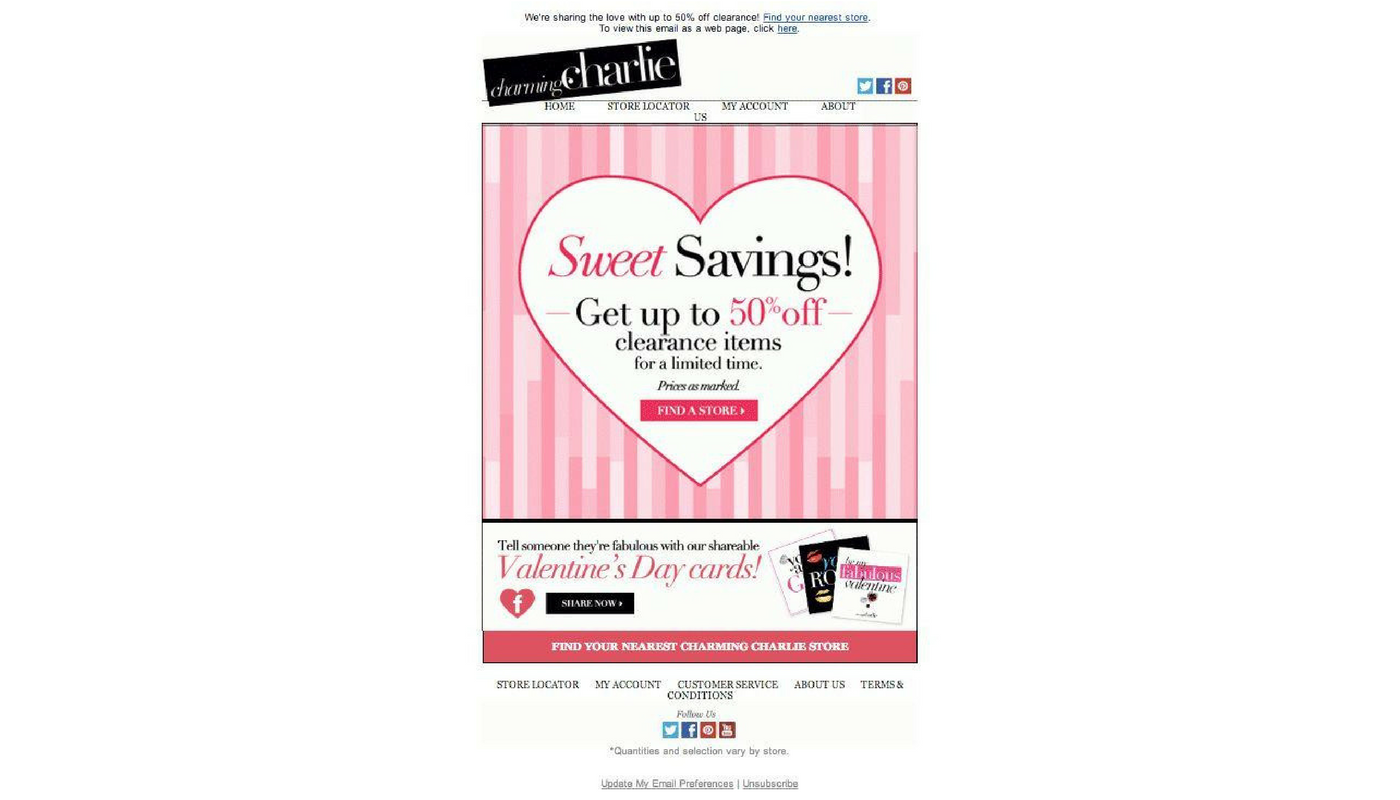
Source: Charming Charlie
This great visual example is at the same time thematic. Sure, hearts can grow a little trite around Valentine’s Day, but one thing is for sure: they do the trick. Anyone who clicks on this email can see right from the start what this promotion is about.
10. Link to the right page
You won’t believe how many amateur email marketers make this mistake — not only in their B2C emails but also in their social media posts. They design an engaging, visual post/email about a huge sale and include a traditional “shop now” call to action that leads… to the main page of a seller’s website. Do not do that! Time is one of the most precious things people have these days, so do not expect your potential buyers to sift through your website looking for the sale you promised. If they don’t see the sale landing page right away, they will simply leave.
While this post is specifically about writing B2C emails for holiday season, all of the above tips are relatively universal, and you can use most of them in any B2B or B2C email marketing campaign, holiday or not. My final word of advice would be to keep your brand voice consistent throughout all of the emails, no matter how much you want to change to adhere to the tips I’ve suggested. This goes for your brand colors, the overall tone and other minor details that make up your wholesome brand image. Keeping a consistent brand image will not only be easier to draft and maintain, but it will also ensure that these 10 tips are able to do their job and help you sell.
Once you’ve improved your holiday emails, let Pixc help you increase your sales! We’ll remove the background from your photos to save you time and make you money. See what we can do for you with a free photo edit today!
This blog was written by Kevin Nelson, a professional educator and a private tutor with over 8 years of experience. He is also a content writer for various blogs about higher education, entertainment, social media & blogging. During his off time, Kevin enjoys traveling and cooking. Feel free to connect with him on Twitter & Linkedin.








